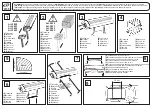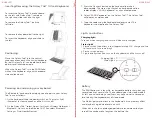
ULTIMATE GIMBAL
Your no tools adjustable gimbal is the most precision designed gimbal ever in the steadicam
industry. Care should be taken so it will provide you with many years of service and reliability. Be careful
not to drop or bend your gimbal fork.
There is not much to tell you about when it comes to the gimbal. To adjust the gimbal up or down
the post, simply turn the Kipp handle to loosen and move the gimbal into position, and retighten. You do
not have to over tighten a gimbal lock on the carbon fiber post. Snug is generally significant enough and
does not need as much force as you might be used to on metal posts.
When making very fine gimbal balance adjustments, I have learned that by turning the gimbal
sleeve a little bit like a screw, that this helps make small adjustments very precise.
One of the unique gimbal sleeve design features is the symmetrical contours on the cap. This
gives the operator the same feel when operating in either high or low mode. The symmetrical fork design
allows considerably more hand room under the gimbal fork in normal mode and you will never have to
worry about pinching your thumb on the fork in low mode. Precise alignment of all three axis, no tools
balance adjustment, complete interchangeability has made this gimbal the most popular gimbal on the
market.
On the standard 115 degree handle is the 10-32 locking screw which is used for tightening the
gimbal handle onto your post in low mode.
Under the foam grip is the standard .1875” through hole in this handle, if you like to use a safety
pin .
If you are using the Ergo handle you will not need the locking screw because you do not flip the
handle over for low mode work.
Gimbal Cleaning & Care
You will find that you most likely will not be disassembling your gimbal and cleaning it very often.
In fact it may be years before you would need to do it, if at all.
Place gimbal wrench pins in two of the matching holes on the gimbal cover.
Hold down on gimbal wrench as picture shows and turn to remove gimbal dust cover. A light tap
with a plastic screwdriver handle may be necessary.
Hold the gimbal upright when removing cap so not to have the fork and bearing cup fall off the
gimbal sleeve. Using the same gimbal wrench, remove the side dust covers on the gimbal fork.
This will reveal the two fork bearings. It is not necessary or recommended to remove the
bearings from the gimbal fork or bearing cup during cleaning, nor is it necessary.
When removing the fork & bearing cap from sleeve be careful to slide it off evenly. It is a perfect
fit.
DO NOT PRY OR TAP THE FORK OR BEARING TO REMOVE OR DISASSEMBLE FROM
SLEEVE
. If the bearing does not remove from sleeve smoothly, put it in the freezer for 20-30
minutes, this will allow the bearing to be easily removed from the gimbal sleeve.
I find cleaning the bearings using a pressurized non-lubricated spray contact cleaner works
perfectly. You can also use an automotive pressurized can of spray carburetor or brake cleaner.
Be advised to wear eye protection when using any pressurized cleaner. I would spray the bearing
and spin them three or four times to remove any dirt and excess cleaner.
4
































